—A basic overview of coping purposes, why it matters, and your material options

In general construction terminology, coping refers to masonry material that is used to cap the top of a wall. Most walls have some type of coping, and the kind that adorns those on gunite pools features specific elements.
Coping is the material—usually natural stone or various forms of concrete—mounted over the top of the pool shell’s “bond beam” (the upper portion of the wall). This is where the pool structure meets the surrounding deck.
Typically, coping is installed in a 12-inch swath around the pool perimeter, as well as the spa. With a few possible exceptions, the entire pool and spa perimeter is finished with coping.
Exceptions usually include rock waterfalls, rim flow spas, and vanishing edges, as well as some beach entries, swim-up bars, and other custom specialty features.
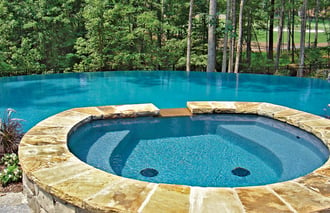
On this dramatic infinity pool, flagstone coping highlights the spa, but the vanishing edge is purposely left “open” without any coping.
Once in place, coping sits above the pool’s tile line. Typically, it extends one to one-and-a-half inches over the water’s surface, thereby creating a small lip or overhang.
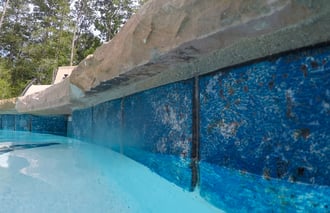
Coping with a chipped edge for an organic look—but buffed to smooth out any sharp edges for a more comfortable grip.
Coping plays an important role on several fronts. Let’s walk through how this feature helps maintains the pool’s structural integrity, boosts swimmer safety and comfort, and enhances a pool’s visual appeal.
Before we do, it’s important to understand, that despite what coping brings to the table, some pools are built with no coping at all.
Coping-free Pools
In some regions of the country—particularly in the Southeast and areas with mild winters and stable soil with little expansion and contraction—coping-free pool construction is common and perfectly appropriate.
On these projects, contractors favor what’s known as “cantilevered decking”. They build a concrete, paver, or stone deck that extends to the pool’s edge and just past it over the water.
So in effect, the edge of the deck takes the place of coping and performs the same comfort and safety functions.
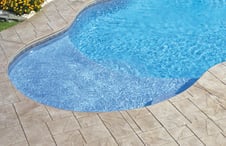
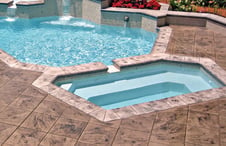
With their cantilever configurations, these stamped concrete decks extend slightly past the pool’s edge and perform double duty for the absent coping.
Structural and performance functions
First and foremost, in most areas of the country, coping is integral to a pool’s construction.
Coping protects the pool’s bond beam and any protruding tips of rebar (steel bars). The mounted material creates a barrier that prevents water from intruding behind the pool wall—a common cause of structural damage.
Because coping does the job of topping off the pool bond beam, no deck is needed for this function. That’s important, because if deck was used for the cap, vulnerabilities could occur: Any shifts in the deck (from soil expansion and contraction) could cause it to lift up off the bond beam—exposing the underlying concrete and steel to the elements.
Coping can make a small contribution to pool maintenance too. By slightly overhanging the inside edges of the pool, coping prevents runoff water (e.g., from hosing down your deck) from streaming down the tile and pool wall. Repeat exposure to untreated water from sources outside the pool can foster staining and calcium building.
On some pools, the coping is configured with a slight outward angle. When high-energy swimmers splash water out of the pool, this slant helps directs the splash out to nearby deck drains. This action reduces water that might otherwise take longer to drain before accumulating on the deck.
Safety, ergonomics, and convenience
Coping makes swimmers safer and more comfortable in several ways.
The most important is how those in the water can grab onto it at the pool’s edge. Away from benches and pool steps, being able to grip the coping makes it easier to pull yourself out of the pool.
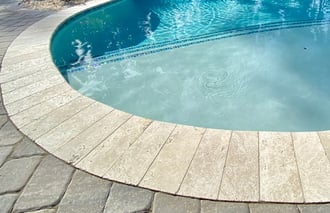
Like kitchen countertops, coping edges come in different shapes. The popular “bullnose” edge is rounded like the letter “c”.
In pools with deep ends, this handhold function is a major asset: Swimmers can grip and hang from it as they tread in deeper water.
Anyone tiring in the middle of the water appreciates nearby coping; they can reach out for it from several feet away, and firmly grasp it to quickly pull themselves to the side of the pool for a rest.
Even in the shallower sections of the pool, being able to easily grip the coping’s edge is helpful for smaller children, shorter adults, and beginning swimmers.

This flagstone coping juts out slightly over the water—providing swimmers with a convenient handhold throughout all or most of the pool’s interior perimeter.
Less critical, but still useful: Coping can help people outside the water in a couple of ways. It serves as a spot on which to sit poolside or atop the spa wall and dangle your feet in the water.
In addition, coping creates extra convenience on those pools built near or all the way up to a fence or wall. In these cases where this “backside” of the pool has no surrounding deck, coping provides a footing to walk along the water’s edge.
If you happen to want a grass lawn instead of a solid deck around your pool, coping makes that possible too. This stone or concrete perimeter provides a buffer between the grass and the water’s edge.
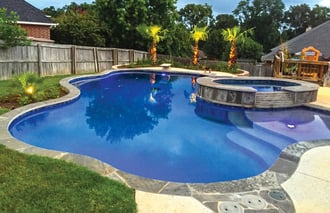
If not for the coping, you or your pool-service pro might have to trudge through grass and landscaping to reach one side of the pool.
Pool Appearance
Aesthetically speaking, coping provides an important visual transition between the water inside the pool and the deck or other surface that surrounds it.

As a key element of the pool’s architectural design, coping provides a superb way to make a style statement.
On some projects, the coping matches the pool deck. For example, you have flagstone decking, and the coping might use the same stone; the major difference is that installers will cut the stone to dimensions proper for coping purposes.
Or, you could choose a coping material that provides a visual contrast with the deck; doing so creates a clearly visible outline that highlights the pool’s shape. An example would be a beige brushed concrete deck paired with stone coping in a dark slate.

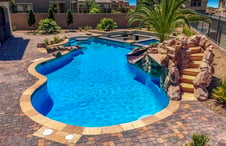
Whether modern, organic, or traditional, the coping can help enhance the pool style theme you want to achieve.
Architects and landscape architects often refer to this coping border as the pool’s “edge treatment.” In fact, many professionals who design and build pools consider this veritable “picture frame” around the water to be among the most important design elements.
The reason why is how the perimeter trim instantly defines the style and function of the structure. coping essentially “announces” the pool’s silhouette.
In fact, just think of the edge of a natural pond. Consider how that organic body of water looks completely different from the clean, distinct outline of a custom pool.
Coping options
Assuming your pool will include coping, you will be choosing a material for your project.
Most options feature some kind of textured, skid-resistant surface. Costs run the gamut, and the price for the exact same material will vary based on the region of the country. Here is a snapshot of the common varieties.
Pre-cast concrete coping “stones”:
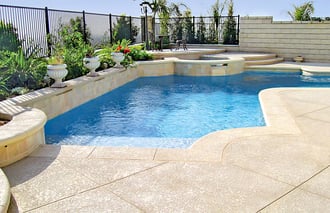
—Wide color array; prefabricated for a pool’s corners, curves, and straight sections; edge-shapes include bullnose, “safety grip,” and right angle with smoothed edges

—Factory-produced squares and rectangles in composite materials; multiple colors; some remain cooler in high heat; easy repairs
Natural stone pavers:
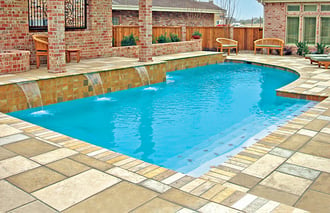
—Cut from slate, limestone, travertine, marble, granite, quartzite, or flagstone; distinctive looks and colors; may require periodic sealing
Poured-in-place concrete:
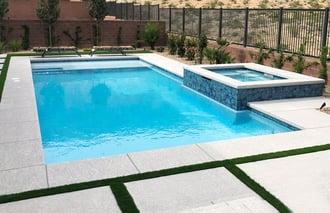
—Highly customizable for color choices and for creating decorative surface patterns;
Organic-shape stones:
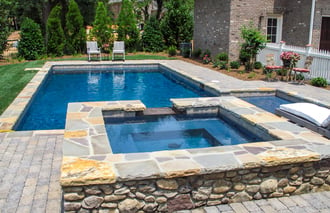
—Natural-cut flagstone or quartzite pieces; random shapes; edges ground smooth for comfort; premium cost
Brick:
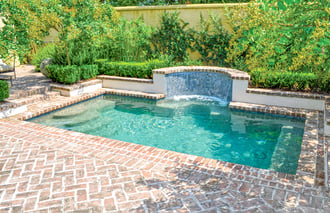
—Affordable; durable; solid or antiqued colors for a traditional look
Take note that options often vary based on where in the country you live. Other factors, such as the kind of pool deck you have, the thematic style of your pool, and your project budget will most certainly come into play.
Consult your pool designer; he or she will explain which kind of coping makes the most sense in your local market, for your particular pool design, and in light of other specific project factors.




.jpg?width=1490&name=rock-waterfall-slide-pool%20(1).jpg)